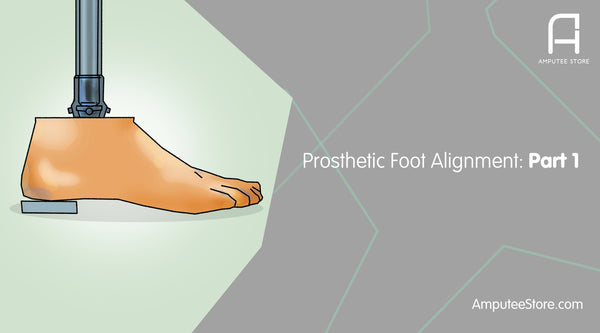Prosthetic Foot Alignment Series: Part 1
In this three-part series, we’ll take you through the basics of prosthetic foot alignment—its importance, how it affects your walking, and how it can cause discomfort. We begin by discussing alignment, viewing alignment changes from front to back (sagittal plane). In part 2, we’ll look at side-to-side prosthetic foot alignment changes.

Regardless of whether you wear a prosthesis or not, everything begins with the foot and works its way up to the knee, hip, and so on. This is commonly referred to as a closed kinetic chain. To illustrate the concept behind the term, imagine that one joint or segment is fixed. This then dictates stress and movements to neighboring joints. As an example, when your prosthetic foot is set too far forward, it transfers a force that throws the knee into extension.
True to the concept, this extended knee causes your hip joint to flex. This reaction continues all the way up to your neck. So, when you have back issues, think of the closed kinetic chain and check your prosthetic foot alignment first.
The reference point
All prosthetic feet come with a manufacturer's recommended alignment reference point, which is typically where the navicular bone or the boat-shaped bone in your ankle would be located.
In a proper alignment set up, a vertical line would fall right through this reference point. This is why you often see your prosthetist using a plumb bob to determine whether this vertical line falls through this foot reference point and the correct point on your knee and socket (more on this later).
When this vertical line falls in front or behind a prosthetic foot's reference point, it can lead to additional stresses transferred within a closed kinetic chain.

Alignment line is too far forward
When your foot is positioned too far back--or the alignment line is too far forward-- this translates to an alignment (vertical) line that passes in front of a foot's reference point. In this instance, a prosthetic user would feel minimal "toe" resistance and little to no energy return overall.
This would then create a related knee instability and a soft mushy feeling in the prosthetic foot—not ideal when running to catch your metro bus or playing sports. Prosthetic feet that are aligned too far back are the root cause of one too many falls because this alignment causes abrupt knee flexion. This is regardless whether you're a below-knee or above-knee prosthetic user.
Alignment line is too far back
Equally frustrating and energy-robbing is when the alignment line is behind the reference point. When this happens, you will feel like you’re walking on a foot that is too long for you. To understand this phenomenon better, imagine yourself trying to walk on a pair of skis. On one leg, the ski binding is attached all the way to the back. When you try to take a step, you’ll notice you have no heel and way too much toe on this leg.
Overcoming this long toe to take advantage of any energy return from your foot is difficult without driving your knee into extension. This type of malalignment can cause excessive knee extension when you place your heel on the ground. Ultimately, your prosthetic heel will feel too hard, non-existent, and clumsy.
Too often, high functioning and capable prosthetic components are rendered inefficient and ineffective by a factor of 4 to 8 degrees. Every turn your prosthetist makes on an alignment screw on your prosthesis, translates to a four-degree alignment change. It's amazing how moving your prosthetic foot forward or backward by a half a centimeter can have such a dramatic effect on your overall comfort and the functional potential of your prosthesis.
Next up, we'll discuss alignment changes that move your foot side-to-side. If you have any questions or concerns, please leave us a comment below.










































































